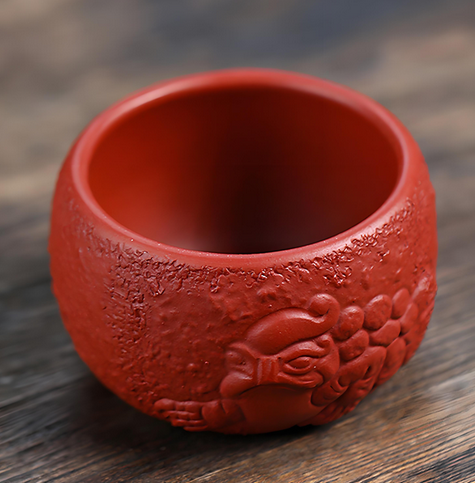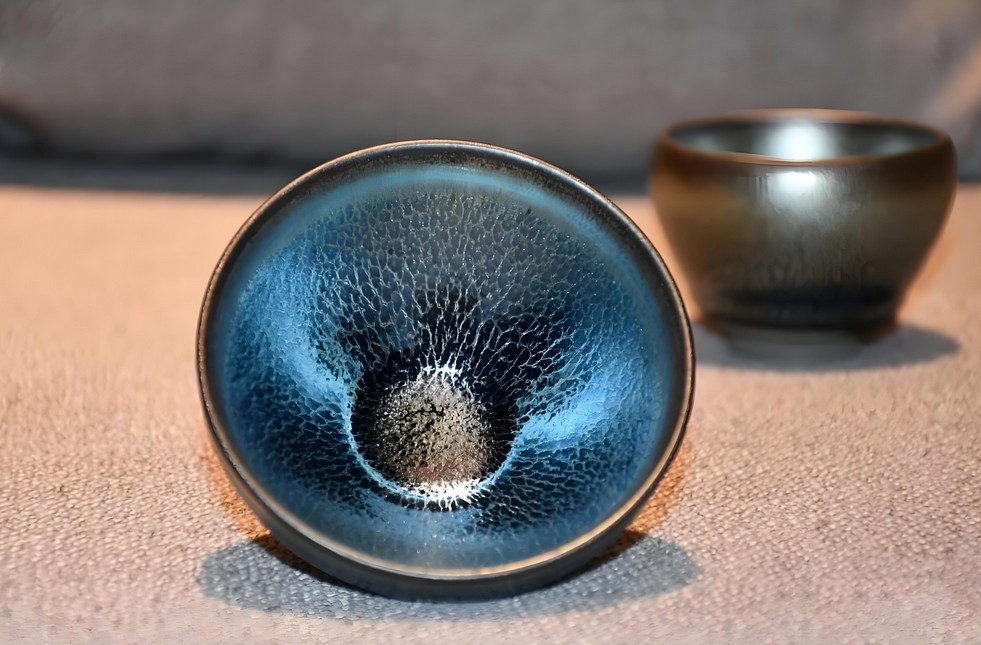Chinese Tea Cups: Where Ancient Artistry Meets Modern Technology
Origins (3000 BCE – Han Dynasty)
The earliest Chinese tea vessels emerged during the Neolithic era as multipurpose clay bowls used for both food and drink. By the Han Dynasty (206 BCE–220 CE), the term chájù (茶具, tea tools) first appeared in literature, marking the formalization of tea culture. Bronze ritual vessels from the Zhou Dynasty (1046–256 BCE) laid the foundation for specialized tea ware, with their intricate designs symbolizing social hierarchy and spiritual reverence.
Tang-Song Golden Age (618–1279)
The Tang Dynasty saw the rise of Longquan celadon, prized for its jade-like glaze and 85% light transmission, ideal for appreciating green tea’s delicate hues. The Song Dynasty perfected Jianyang black-glazed cups, whose “hare’s fur” patterns enhanced the visual drama of tea froth during diancha (点茶, whisked tea) rituals. These innovations reflected Zen Buddhist philosophies and imperial aesthetics.
Ming-Qing Global Influence (1368–1912)
Ming Emperor Hongwu’s decree to abolish compressed tea cakes popularized loose-leaf brewing, simplifying tea ware to three essentials: zisha (purple clay) teapots, porcelain cups, and storage jars. The Qing Dynasty’s blue-and-white porcelain became a global sensation via the Maritime Silk Road, with designs blending Chinese motifs with European botanical patterns for export markets.
Material Science: The Alchemy of Tea Ware
1. Zisha (Purple Clay)
- Composition: Iron-rich terracotta from Yixing’s Huanglong Mountain, fired at 1180°C to create 0.1–10μm dual pores.
- Function: Enhances oxidation in oolong and pu-erh, increasing mellowness by 23%.
- Iconic Piece: Chen Mingyuan’s Peach Blossom Teapot (Qing Dynasty), carved with Taoist landscapes symbolizing harmony.

2. Porcelain
- Celadon: Song Dynasty Ru Kiln cups with “sky-blue” glaze, achieving 72-hour reduction firing for jade-like refraction.
- Dehua “Blanc de Chine”: 0.8mm translucent walls preserve jasmine tea’s aroma layers.
- Black Glaze: Jian Zhan (建盏) cups with metallic streaks optimized for Song-era tea competitions.

3. Glass & Modern Innovations
- High Borosilicate Glass: 3.3W/m·K thermal conductivity cools tea 40% faster than ceramic, ideal for Longjing’s tender leaves.
- Smart Cups: Ember Cup’s PID algorithm maintains ±1°C precision for pu-erh (95°C) and matcha (80°C).
- Eco-Materials: Bamboo fiber 3D-printed cups reduce kiln emissions by 38%.
Iconic Teacups Through Dynasties
| Dynasty | Masterpiece | Key Features |
|---|---|---|
| Ming | Yongle Blue-White Flared Rim Cup | 12-stroke dragon motifs symbolizing imperial authority |
| Qing | Kangxi Famille Rose Cup | European floral patterns fused with Qinghua blue |
| Modern | Jingdezhen “7501 Mao Porcelain” | 0.01mm ultra-thin walls fired at 1380°C for jade-like translucency |
Tea Pairing Guide: Science Meets Ritual
| Tea Type | Ideal Cup | Scientific Rationale | Cultural Context |
|---|---|---|---|
| Green Tea | Celadon/Longquan | 85% light transmission enhances visual clarity | Morning refreshment in Jiangnan |
| Pu-erh | Yixing Zisha | Dual pores accelerate polyphenol oxidation | Afternoon meditation sessions |
| Oolong | Thin-Walled White Porcelain | Rapid heat dissipation preserves floral notes | Fujian Gongfu tea ceremonies |
| Black Tea | Gold-Rimmed Porcelain | Metallic edges amplify malt aroma | British-style afternoon tea |
| Herbal Tea | Glass with Infuser | Transparency showcases botanical aesthetics | Office wellness breaks |
Teacup Future Trends: Bridging Tradition & Technology
- AR-Enabled Teacups
Scan QR codes to view brewing tutorials or dynamic art (e.g., Palace Museum’s A Thousand Li of Rivers and Mountains). - NFT Authentication
Blockchain-certified limited editions combat counterfeiting in antique markets. - Sustainable Craftsmanship
Rice husk ash glaze reduces lead leaching by 90% while increasing hardness.
Chinese Tea Cup Cultural Resonance & Global Impact
From Tang Dynasty chaji (茶技, tea art) to Hermès × Jingdezhen collaborations blending French minimalism with Qing motifs, Chinese tea cups transcend functionality. As British collector James noted, “A Ming-era chicken cup isn’t just porcelain—it’s a dialogue with history”.
- Chinese Kung Fu Tea
- Chinese Tea Ceremony
- Chinese Tea Culture and History
- Chinese Tea Knowledge
- Health Benefits of Chinese Tea
- How to Brew Chinese Tea
- Tea Learning
- Types of Chinese Tea
- Types of Chinese Tea Sets
Aged Dark Tea aged pu erh tea Aged Tea Baihao Yinzhen benefits of white tea Blacktea black tea black tea benefits Chinese black tea Chinese Dark Tea Chinese Oolong Tea Chinese Pu Erh Tea Chinese tea Chinese tea culture chinese tea from china chinese tea in chinese Chinese white tea dark tea Fuding White Tea green tea how to brew white tea liubao tea oolong oolong tea Premium Loose‑Leaf Tea Pu Erh Tea puer tea pu er tea ripe pu erh tea Rock Tea Silver Needle silver needle white tea tea tea chinese tea White Peony tea (Bai Mudan) white tea white tea shot white tea shots wulong wulong tea Wuyi Rock Oolong Tea Wuyi Rock Tea wu yi tea Yunnan Pu Erh Tea Is Pu-erh Tea a Black Tea



